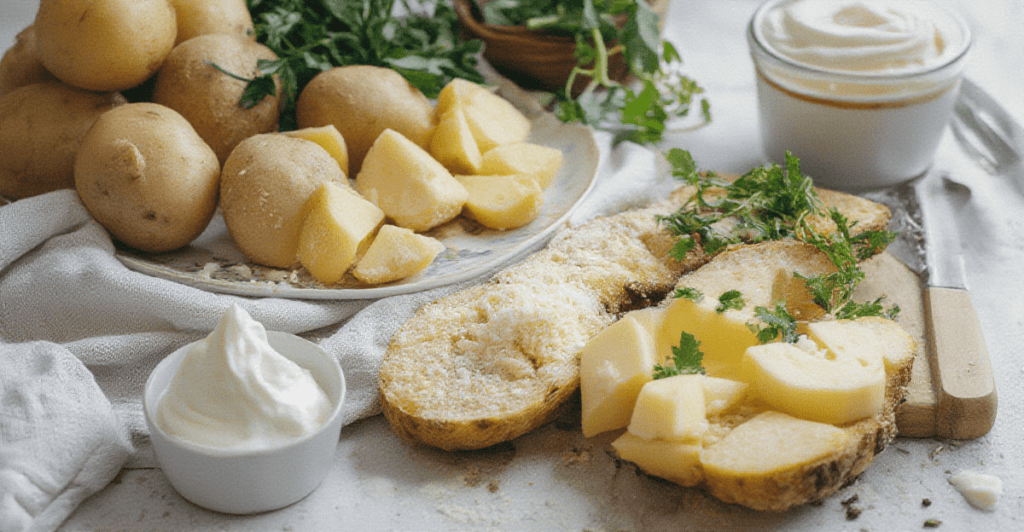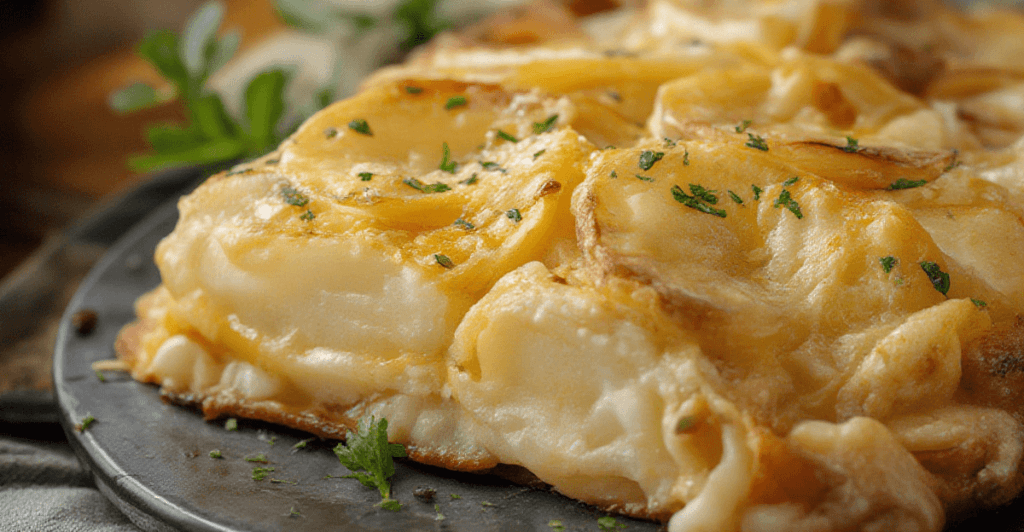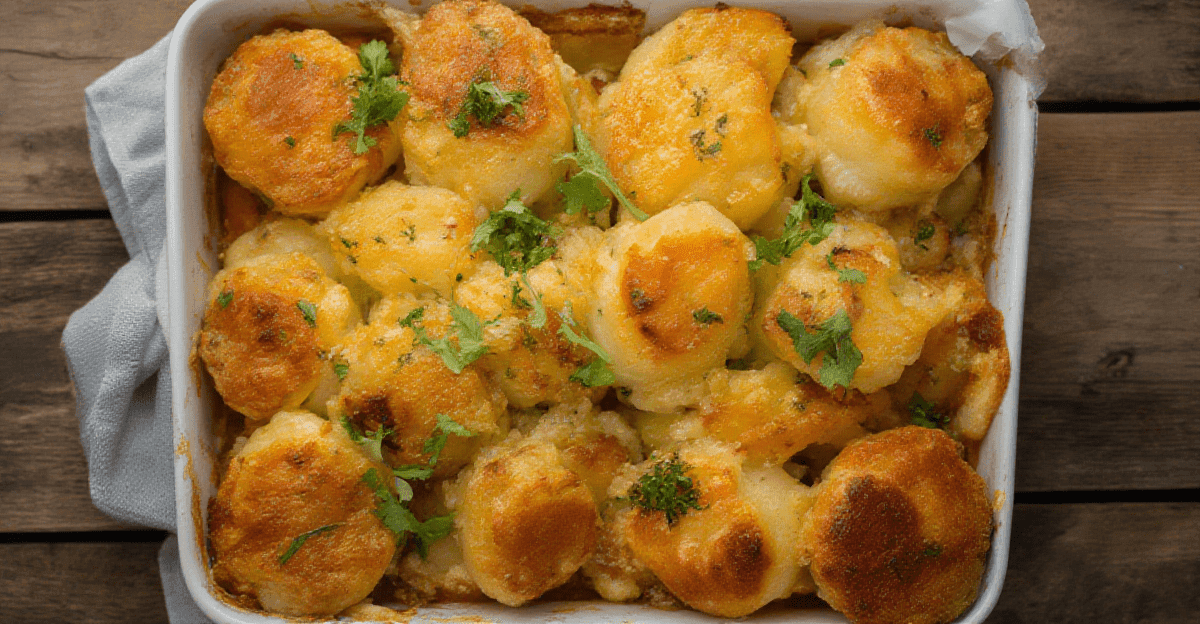Who doesn’t love a warm, comforting dish of scalloped potatoes? And when you add the creamy, savory goodness of cheese powder, it takes this classic side dish to a whole new level. Whether you’re hosting a family dinner or just craving something rich and satisfying, this recipe will hit the spot. Let’s dive into how you can create the ultimate scalloped potatoes using cheese powder.
Why Use Cheese Powder in Scalloped Potatoes?
Cheese powder might not be the first ingredient you think of when making scalloped potatoes, but it’s a game-changer. Here’s why:
Convenience and Shelf Life
Unlike fresh cheese, cheese powder is shelf-stable and doesn’t require refrigeration. This makes it a great option for those days when you want a cheesy dish but don’t have fresh cheese on hand. Plus, it dissolves easily into liquids, creating a smooth, lump-free sauce.
Rich and Consistent Flavor
Cheese powder delivers a bold, cheesy flavor that doesn’t vary as much as some fresh cheeses might. You can count on it to deliver that signature savory taste every time, ensuring your scalloped potatoes turn out perfect.
Ingredients for Scalloped Potatoes Recipe with Cheese Powder

Before we start cooking, let’s gather everything we need.
Main Ingredients
- Potatoes: 5–6 medium-sized potatoes (Russet or Yukon Gold work best)
- Cheese Powder: ½ cup (adjust based on taste)
- Butter: 2 tablespoons
- Cream: 1 cup
- Milk: 1 cup
Optional Add-ons
- Onions: Thinly sliced for extra flavor
- Garlic: Minced or powdered, for a hint of savory depth
- Herbs: Fresh parsley, thyme, or chives for garnish
Step-by-Step Instructions for Making Scalloped Potatoes
Preparing the Ingredients
- Slice the Potatoes: Peel the potatoes (if desired) and slice them thinly, about 1/8 inch thick. Using a mandoline slicer can save time and ensure even slices, which is key for even cooking.
- Mix the Sauce: In a bowl, whisk together the cheese powder, cream, and milk until smooth. Add a pinch of salt and pepper to taste. For a richer flavor, you can also mix in a teaspoon of garlic powder or a hint of paprika.
Layering the Potatoes
- Grease the Dish: Preheat your oven to 375°F (190°C). Grease a baking dish with butter or cooking spray to prevent sticking.
- Layer the Slices: Arrange the potato slices in a single layer on the bottom of the dish. Overlap the edges slightly for a prettier presentation.
- Pour the Sauce: Spoon a portion of the cheese mixture over the layer of potatoes, spreading it evenly.
- Repeat: Continue layering potatoes and sauce until all the ingredients are used, finishing with a generous layer of sauce on top.
Baking the Dish to Perfection
- Cover and Bake: Cover the baking dish with aluminum foil to lock in moisture. Bake in the preheated oven for 30 minutes.
- Uncover for Golden Brown Top: Remove the foil and bake for an additional 20–25 minutes or until the potatoes are tender and the top is golden and bubbly.
- Let It Rest: Allow the dish to cool for 5–10 minutes before serving. This helps the sauce thicken and makes it easier to serve.
Tips for the Best Scalloped Potatoes
Choosing the Right Potatoes
Not all potatoes are created equal. For the best texture, go for Russet or Yukon Gold potatoes. Russets are starchy and absorb the sauce beautifully, while Yukon Golds offer a creamy texture and buttery flavor.
How to Prevent Curdling
One of the biggest challenges with scalloped potatoes is avoiding curdled sauce. To prevent this:
- Use full-fat cream and milk for a stable base.
- Whisk the cheese powder thoroughly into the liquid to dissolve it completely.
Adding Extra Flavor
Want to take your scalloped potatoes to the next level? Sprinkle a layer of caramelized onions between the potato slices or add a dash of smoked paprika for a subtle kick.
“The secret to perfect scalloped potatoes is all in the layering. Even slices and a smooth sauce ensure every bite is creamy and flavorful.”
Common Problems and Solutions
Potatoes Not Cooking Evenly
This happens when slices are uneven. Always aim for uniform thickness to ensure even cooking. Using a mandoline slicer is a game-changer.
Sauce Too Thin or Thick
If the sauce is too runny, it might be because the ratio of liquid to cheese powder was off. To fix this:
- Thin Sauce: Simmer the sauce on the stovetop before pouring it over the potatoes.
- Thick Sauce: Add a splash of milk to thin it out.
Serving Ideas for Scalloped Potatoes

Once you’ve perfected your scalloped potatoes recipe with cheese powder, it’s time to share the love and serve them in a way that highlights their creamy, cheesy goodness. Here are some friendly and fun ideas to inspire your next meal:
Pair with Protein
Scalloped potatoes are a versatile side dish that pairs well with almost any main course. Some crowd-pleasing options include:
- Grilled Chicken or Steak: The richness of the potatoes balances beautifully with the smoky flavors of grilled meats.
- Baked Ham: A classic combination, especially for holiday dinners. The salty ham highlights the creamy potatoes perfectly.
- Roasted Vegetables: For a vegetarian option, pair with roasted Brussels sprouts, carrots, or asparagus.
Add a Fresh Salad
To lighten up the meal, serve scalloped potatoes with a crisp green salad. A lemon vinaigrette can cut through the richness and provide a refreshing contrast.
Serve as a Standalone Dish
These scalloped potatoes are hearty enough to be a meal on their own. Add a side of crusty bread and a glass of wine, and you’ve got yourself a cozy dinner.
Common Problems and Solutions
Why Are My Potatoes Hard After Baking?
Hard potatoes are often a result of insufficient cooking time or using the wrong type of potato. Here’s how to fix it:
Solution: Always use starchy potatoes like Russet or Yukon Gold. If you notice the potatoes aren’t fully cooked, cover the dish with foil and bake for an additional 15–20 minutes.
How Do I Get a Crispy Top?
The crispy, golden-brown top is one of the best parts of scalloped potatoes. If yours isn’t browning, try this:
Solution: Remove the foil during the last 20 minutes of baking and increase the oven temperature slightly. For extra crispiness, broil the dish for 2–3 minutes, keeping a close eye to prevent burning.
How Can I Fix a Bland Flavor?
If your scalloped potatoes recipe with cheese powder tastes a bit bland, don’t worry—it’s likely just due to under-seasoning. A friendly tip: here’s how to enhance the flavor and make your dish shine:
Solution: Add salt and pepper generously to each layer of potatoes. You can also sprinkle in garlic powder, onion powder, or even a pinch of nutmeg for a more complex flavor profile.
Adding a Gourmet Touch
If you’re looking to elevate this dish, consider these gourmet additions:
Mix in Other Cheeses
While cheese powder is the star of this recipe, adding other cheeses can create a multi-dimensional flavor. Gruyère, cheddar, or even blue cheese work well.
Include Protein Layers
For a more filling dish, add cooked, crumbled bacon or diced ham between the potato layers. It’s a simple way to transform scalloped potatoes into a complete meal.
Experiment with Herbs and Spices
Fresh thyme, rosemary, or sage can add an earthy depth to the dish. For a spicy kick, sprinkle in a bit of cayenne pepper or red pepper flakes.
Variations of Scalloped Potatoes with Cheese Powder
If you’ve mastered the classic scalloped potatoes recipe with cheese powder, why not get creative and have some fun with it? There are plenty of friendly and delicious ways to put a unique spin on this comforting dish. Here are a few exciting variations to try:
Loaded Scalloped Potatoes
Take inspiration from loaded baked potatoes and add toppings like:
- Cooked Bacon: Crumble it between layers for a smoky flavor.
- Green Onions: Sprinkle chopped green onions or chives on top before serving.
- Sour Cream: Add a dollop on the side for a tangy contrast.
Spicy Scalloped Potatoes
If you like a little heat, try these additions:
- Jalapeños: Add thinly sliced jalapeños between layers.
- Cayenne Pepper: Mix a pinch into the cheese sauce.
- Hot Sauce Drizzle: Serve with a drizzle of your favorite hot sauce for an extra kick.
Vegetable-Enhanced Scalloped Potatoes
Add some veggies to make this dish even heartier:
- Spinach or Kale: Layer cooked greens between the potatoes.
- Mushrooms: Sauté mushrooms and include them in the layers.
- Broccoli or Cauliflower: Blanch florets and add them for a cheesy veggie bake.
Healthier Alternatives
If you’re looking for a lighter version of scalloped potatoes, there are several tweaks you can make without sacrificing flavor.
Use Low-Fat Ingredients
- Substitute whole milk with low-fat or plant-based milk.
- Use reduced-fat cheese powder for a lighter sauce.
Swap Potatoes for Other Vegetables
For a lower-carb option, replace some or all of the potatoes with:
- Zucchini or Yellow Squash: Thinly slice and layer as you would with potatoes.
- Sweet Potatoes: Add a hint of natural sweetness.
- Turnips or Parsnips: Offer a slightly nutty flavor profile.
Reduce the Sauce
Cut back on the sauce by using a thin layer for each potato layer when making your scalloped potatoes recipe with cheese powder. This friendly tweak still delivers all the cheesy flavor you love while keeping the dish a bit lighter on calories.
Printable Recipe Card
Here’s a quick and easy-to-follow recipe card for your convenience:
Scalloped Potatoes with Cheese Powder Recipe
Prep Time: 15 minutes
Cook Time: 50 minutes
Total Time: 1 hour 5 minutes
Serves: 6
Ingredients
- 5–6 medium potatoes (Russet or Yukon Gold)
- ½ cup cheese powder
- 2 tablespoons butter
- 1 cup cream
- 1 cup milk
- Salt and pepper to taste
- Optional: sliced onions, minced garlic, fresh herbs
Instructions
- Preheat the oven to 375°F (190°C) and grease a baking dish.
- Slice the potatoes thinly (about 1/8 inch thick).
- Whisk cheese powder, cream, and milk together in a bowl. Season with salt and pepper.
- Arrange potato slices in a single layer in the baking dish. Pour a portion of the cheese sauce over the layer.
- Repeat layering until all ingredients are used, finishing with a layer of cheese sauce.
- Cover with foil and bake for 30 minutes. Remove the foil and bake for another 20–25 minutes, until the top is golden and bubbly.
- Let rest for 5–10 minutes before serving.
Enjoy your creamy, cheesy scalloped potatoes!
Storage and Reheating Tips
If you’ve got leftovers (lucky you!), here’s how to store and reheat them:
Storage
- Refrigerator: Place leftovers in an airtight container and store for up to 3–4 days.
- Freezer: Cool the dish completely, then wrap it tightly with plastic wrap and aluminum foil. Store in the freezer for up to 3 months.
Reheating
- Oven: Cover the dish with foil and reheat at 350°F (175°C) for 20 minutes or until heated through.
- Microwave: Heat individual portions on medium power for 2–3 minutes, stirring halfway through.
Fun Serving Ideas
For a creative twist, serve your scalloped potatoes in individual ramekins or small cast iron skillets. Not only does this make for a stunning presentation, but it also ensures everyone gets their own crispy, cheesy edges.
Final Thoughts
Scalloped potatoes with cheese powder are the ultimate comfort food, and they’re a breeze to whip up for any occasion. They’re creamy, cheesy, and incredibly versatile, with just the right touch of cheesy goodness to make everyone smile. Whether you’re sticking with the classic recipe or trying out one of the many friendly variations, this dish is bound to become a favorite in your household.
So grab your ingredients, preheat that oven, and let the aroma of cheesy potatoes fill your kitchen. Your taste buds—and anyone lucky enough to share the meal—will thank you!
FAQs
How do you use cheese seasoning powder?
Cheese seasoning powder is incredibly versatile and easy to use. Here’s how:
- As a Sauce Base: Whisk cheese powder into warm milk, cream, or butter to create a smooth, creamy cheese sauce for dishes like scalloped potatoes, mac and cheese, or nachos.
- For Dry Seasoning: Sprinkle it directly onto popcorn, chips, or roasted vegetables for a cheesy, flavorful kick.
- In Baking or Cooking: Mix it into batters, bread dough, or even mashed potatoes for extra cheesiness.
- In Layered Dishes: Combine cheese powder with cream to pour over potato layers, as done in scalloped potato recipes.
What is the one trick Michael Symon uses to make perfect scalloped potatoes?
Michael Symon’s trick for perfect scalloped potatoes lies in infusing the cream with aromatics. He heats the cream or milk with garlic, thyme, and bay leaves before layering it with potatoes. This step enhances the flavor without overpowering the dish, ensuring the potatoes absorb a rich, savory taste. Additionally, Symon emphasizes using starchy potatoes like Russets to achieve the perfect creamy texture.
How do you make Paula Deen’s scalloped potatoes?
Paula Deen’s scalloped potatoes are famous for their simplicity and Southern charm. Here’s a general method based on her style:
- Ingredients: Potatoes, butter, heavy cream, milk, onions, cheddar cheese, and seasonings like salt and pepper.
- Steps:
- Thinly slice potatoes and onions.
- Create a sauce by combining butter, milk, and cream over low heat, stirring in shredded cheese until smooth.
- Layer potatoes and onions in a baking dish, pouring cheese sauce over each layer.
- Bake at 375°F (190°C) until the top is golden and the potatoes are tender (about 1 hour).
- Tip: Paula often suggests adding extra shredded cheese on top for a gooey, bubbly finish.
What is the difference between scalloped potatoes and au gratin potatoes?
While they are similar, scalloped potatoes and au gratin potatoes have key differences:
- Cheese:
- Scalloped Potatoes: Traditionally, they rely on a cream-based sauce, and cheese is optional (though commonly added in modern recipes).
- Au Gratin Potatoes: Always include cheese, either layered with the potatoes or sprinkled on top for a crispy, golden crust.
- Cut Thickness:
- Scalloped Potatoes: The potatoes are sliced slightly thicker (around 1/8 to 1/4 inch).
- Au Gratin Potatoes: The slices are thinner, allowing for a more delicate and layered texture.
- Topping:
- Scalloped Potatoes: Rarely include a breadcrumb topping.
- Au Gratin Potatoes: Often topped with breadcrumbs and cheese for added crunch.
- Flavor Profile:
- Scalloped potatoes focus on creamy simplicity.
- Au gratin potatoes are richer and cheesier, thanks to the cheese and breadcrumb combination.
Both dishes are comforting, but au gratin potatoes tend to feel a bit more indulgent!
Conclusion
Scalloped potatoes and their cheesy counterparts like au gratin potatoes are classic comfort foods that stand the test of time. Whether you’re using cheese powder for a quick and flavorful twist or exploring variations inspired by culinary legends like Michael Symon and Paula Deen, these dishes are versatile and satisfying.
Cheese seasoning powder makes it easy to create a rich, creamy sauce, and the small tweaks you learn—like infusing the cream or perfecting the potato slice thickness—can elevate your recipe from ordinary to extraordinary. Whether you prefer the simplicity of scalloped potatoes or the indulgence of au gratin, there’s no wrong choice when it comes to serving up layers of cheesy, creamy goodness.

